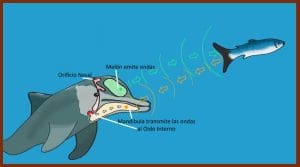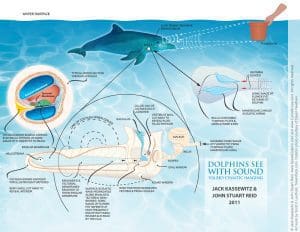
Dolphins, as highly intelligent and social marine mammals, have long fascinated scientists and observers alike. One of the most intriguing aspects of their behavior is how they communicate with one another. Dolphins possess a remarkable ability to exchange information, coordinate activities, and form complex social bonds through their unique communication system. Understanding how dolphins communicate not only provides insights into their fascinating underwater world but also sheds light on the intricate dynamics of animal communication. In this article, we will explore the various methods and signals dolphins use to convey messages to their peers, unraveling the mysteries of their remarkable communication skills. From vocalizations to body language, we will delve into the depths of dolphin communication, revealing the sophistication and intricacy of their underwater conversations. Join us on this captivating journey into the realm of dolphin communication and discover the secrets behind their extraordinary ability to connect and interact with one another.
Contents
- Systems of Dolphin Communication.
- Social Structure and Communication.
- Dolphin pods typically consist of a core group of individuals that form strong social bonds.
- Communication is a fundamental aspect of dolphin social interactions.
- Body language and physical interactions also play an essential role in dolphin communication.
- Studying the social structure and communication of dolphins requires a multi-faceted approach.
- Scientific Research on Dolphin Communication.
- One area of scientific research focuses on the vocalizations of dolphins.
- Another aspect of research explores the social dynamics and behaviors associated with dolphin communication.
- Scientific research has also delved into the emotional aspects of dolphin communication.
- Technological advancements have played a crucial role in studying dolphin communication.
- Importance of Communication in the Lives of Dolphins.
Systems of Dolphin Communication.
Dolphins employ a variety of communication systems to interact and convey information within their social groups. These systems consist of both vocalizations and non-vocal behaviors, each serving different purposes in their underwater world. Understanding the intricacies of these communication systems is crucial for unraveling the complex social dynamics and behaviors exhibited by dolphins.
Vocalizations are a primary means of communication for dolphins.
They produce a wide range of sounds, including clicks, whistles, and burst-pulse sounds. Clicks are short, broadband sounds used for echolocation, helping dolphins navigate their environment and locate prey. Whistles, on the other hand, are longer and more tonal sounds, often referred to as signature whistles. Each dolphin develops a unique signature whistle early in life, acting as a form of individual identification and potentially facilitating social bonding within their group.
Dolphins use vocalizations to convey a wealth of information.
They can communicate their location, social status, and intentions through variations in pitch, frequency, and rhythm. Research suggests that dolphins are capable of producing complex vocal sequences, displaying a remarkable level of vocal mimicry and learning. These vocalizations can carry emotional nuances, allowing dolphins to express their intentions and emotions to their peers.
Beyond vocalizations, dolphins employ non-vocal behaviors as an additional means of communication. These behaviors include body postures, movements, and facial expressions. Dolphins are known for their acrobatic displays, such as leaps, flips, and tail slaps, which can convey messages related to social bonding, playfulness, or territorial displays. They also use body postures and movements, such as head bobs, pectoral fin extensions, and jaw claps, to communicate specific messages within their group.
Furthermore, dolphins engage in tactile communication, often rubbing against each other or performing body contact behaviors. These physical interactions play a significant role in reinforcing social bonds and affiliations within dolphin communities.
Studying dolphin communication.
Studying dolphin communication systems requires a combination of audio recordings, behavioral observations, and advanced technology. Researchers use hydrophones to record and analyze dolphin vocalizations, allowing them to decipher the meaning behind different sounds and their contextual usage. Additionally, underwater cameras provide valuable visual data, capturing the intricacies of dolphin body language and non-vocal behaviors.
Through the study of these communication systems, scientists continue to unravel the rich tapestry of dolphin social interactions, shedding light on their intelligence, social structures, and unique ways of conveying information. Understanding how dolphins communicate not only deepens our knowledge of these magnificent creatures but also offers insights into the broader field of animal communication and cognition.
Social Structure and Communication.
Dolphins are highly social animals that live in complex social structures known as pods. Within these pods, dolphins engage in intricate communication behaviors that play a crucial role in maintaining social bonds, coordinating activities, and navigating their environment. Understanding the social structure and communication dynamics of dolphins provides valuable insights into their cooperative behaviors, group cohesion, and overall social dynamics.
These bonds are often based on familial relationships, with related individuals forming the foundation of the pod. However, pods can also include unrelated individuals, creating a diverse mix of ages and genders. Within the pod, a hierarchical structure exists, with dominant individuals exerting influence and establishing social order.
Dolphins utilize a combination of vocalizations, body language, and tactile behaviors to convey messages and maintain social cohesion. Vocalizations, such as clicks, whistles, and burst-pulse sounds, serve as primary means of communication. Clicks are used for echolocation purposes, assisting dolphins in navigating their surroundings and locating prey. Whistles, on the other hand, are longer, more tonal sounds that serve as signature whistles—unique vocalizations specific to individual dolphins. These signature whistles are believed to facilitate individual recognition, social bonding, and communication within the pod.
Body language and physical interactions also play an essential role in dolphin communication.
Dolphins engage in a wide range of behaviors, including leaps, tail slaps, head bobs, and pectoral fin extensions, which convey messages related to playfulness, aggression, dominance, or courtship. These behaviors, combined with tactile interactions such as rubbing and nuzzling, contribute to the formation and reinforcement of social bonds within the pod.
The social structure and communication of dolphins are closely intertwined. Communication facilitates cooperation, coordination, and decision-making within the pod. Dolphins use their communication signals to coordinate hunting efforts, engage in synchronized behaviors, and allocate tasks during group hunting activities. The ability to effectively communicate allows dolphins to work together, increasing their chances of successful hunting and survival.
Researchers utilize advanced technologies, including underwater microphones and cameras, to record and analyze vocalizations and behaviors. These studies help unravel the complexities of dolphin communication and its impact on their social dynamics.
Understanding the social structure and communication patterns of dolphins not only provides insights into their fascinating underwater world but also offers valuable comparisons to other social species. Dolphin communication highlights the significance of cooperative behaviors, social bonds, and effective communication in the animal kingdom, showcasing the sophistication and complexity of their social lives.
Scientific Research on Dolphin Communication.
Dolphin communication has been a subject of extensive scientific research aimed at unraveling the mysteries of how dolphins communicate with each other. Scientists have employed various methodologies and technologies to study their vocalizations, behavioral patterns, and social interactions. Through these studies, researchers have made significant discoveries about the complexities of dolphin communication and its importance in their lives.
One area of scientific research focuses on the vocalizations of dolphins.
Researchers have recorded and analyzed the wide range of sounds produced by dolphins, including clicks, whistles, and burst-pulse sounds. These vocalizations serve different purposes, such as echolocation, individual recognition, and social bonding. Scientists have studied the acoustic properties of these vocalizations to identify patterns, meanings, and variations in different contexts.
Scientists have observed the interactions and behaviors displayed by dolphins within their social groups, studying body postures, movements, and gestures. Through these observations, researchers have identified specific behaviors related to courtship, aggression, playfulness, and cooperation. They have also examined the role of tactile interactions, such as rubbing and physical contact, in fostering social bonds and conveying messages.
Scientific research has also delved into the emotional aspects of dolphin communication.
By analyzing the acoustic features and contextual information of vocalizations, scientists have identified variations that convey different emotions, such as excitement, distress, or social bonding. Understanding the emotional expressions of dolphins contributes to a more comprehensive understanding of their communication and social interactions.
Technological advancements have played a crucial role in studying dolphin communication.
Hydrophone arrays have allowed researchers to record and analyze dolphin vocalizations underwater, enabling precise identification and tracking of individual dolphins based on their unique acoustic signatures. Underwater cameras and video recordings have provided valuable visual data, capturing the body language and behavioral sequences that accompany dolphin communication.
Scientific research on dolphin communication not only sheds light on the fascinating abilities and social dynamics of dolphins but also offers insights into broader questions about animal communication and cognition. Understanding how dolphins communicate can have implications for conservation efforts, animal welfare, and the study of communication in other species. By expanding our knowledge of dolphin communication, scientists contribute to a deeper appreciation and conservation of these remarkable marine creatures.
Importance of Communication in the Lives of Dolphins.
In conclusion, communication plays a vital role in the lives of dolphins, serving as the foundation of their social interactions, coordination of activities, and survival in their marine environment. Through their complex vocalizations, body language, and tactile behaviors, dolphins are able to convey information, establish social bonds, and navigate their social hierarchies. The sophisticated communication systems of dolphins allow them to coordinate cooperative behaviors, such as hunting and group dynamics, enhancing their chances of success
If you want to know why humpback whales perform acrobatics, click here.


